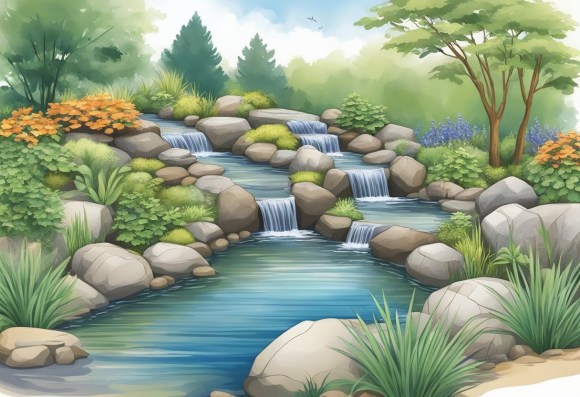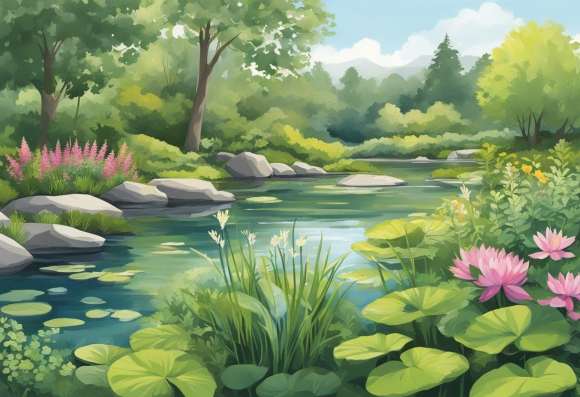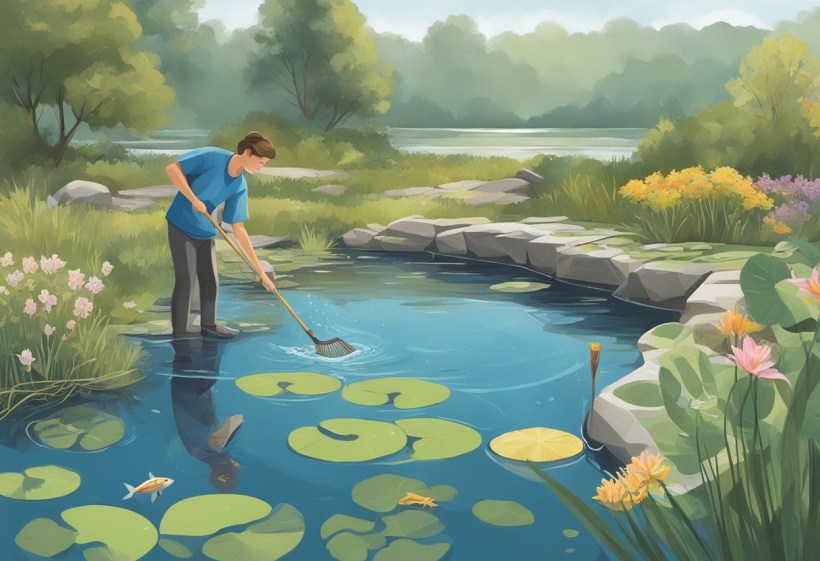Creating a welcoming haven for wildlife in your garden enhances the overall ecosystem and brings a dynamic energy to your outdoor space. A wildlife pond is a significant contribution, supporting a range of aquatic creatures and providing a vital water source for birds and mammals. Constructing a pond that favours wildlife doesn’t just add to the aesthetic appeal of your garden – it becomes a focal point for natural activity and encourages biodiversity.
Maintenance is key to a successful wildlife pond. Regular upkeep ensures the water remains healthy, preventing overgrowth that can suffocate the pond’s inhabitants or lead to stagnation. Engaging in careful maintenance also means you’ll help sustain the balance of the pond’s ecosystem, which in turn fosters a welcoming environment for creatures big and small.
When considering the placement and design of your pond, remember to position it so it captures sunlight and avoid areas directly beneath trees. This way, you’ll aid in the growth of beneficial plants while minimising the workload of clearing fallen leaves.
Also, by varying the depth and including shallower areas, you’ll create a space that can accommodate a broader range of wildlife, providing everything from drinking spots to breeding grounds.
Selecting the Perfect Location

Before you start creating a wildlife-friendly pond, identifying the right spot in your garden is vital. It should balance sunlight with shade and be free from common issues that could compromise the pond’s health and attractiveness to wildlife.
Understanding Sunlight and Shade
Your pond needs ample sunlight to support plant life, but also shaded areas to keep it from overheating. Aim for about 4-6 hours of sunlight per day.
Place the pond where it can receive morning sunlight, which is less intense than the afternoon’s. If you have trees in your garden, consider their positions to ensure they won’t over-shade the pond or fill it with leaves.
- Sunlight Matters: Ponds require sunlight for aquatic plants to photosynthesise and offer oxygen to the water dwellers.
- Balance is Key: A mixture of sun and shade throughout the day helps maintain a healthy temperature and ecosystem balance.
Avoiding Common Pitfalls
When scouting for the perfect location, keep away from areas that might flood during heavy rainfall. Avoid placing your pond close to deciduous trees to reduce leaf litter and nutrient overload, which could lead to algae problems.
Additionally, steer clear of areas with heavy foot traffic to ensure a peaceful shelter for wildlife.
- Steer Clear of Trees: Situate away from deciduous trees to reduce excess organic matter in the pond.
- Mind Potential Flood Areas: Choose a higher ground spot to prevent flooding and protect your pond’s ecosystem.
Pond Construction Essentials

When starting your wildlife pond, keep in mind that every design decision impacts the local ecosystem. The right materials and structure can create a thriving habitat for various species.
Designing with Wildlife in Mind
To construct a wildlife-friendly pond, begin by digging a hole with varying water depths. Include a shallow area for birds and amphibians, and deeper zones for fish and aquatic insects. Gradually sloping sides allow easy access for wildlife and provide different micro-habitats.
Choosing the Right Liner and Underlay
Selecting a durable liner is essential for retaining water and avoiding leaks. Pair the liner with an underlay to protect against punctures from stones or roots. The right liner and underlay ensure a long-lasting pond that’s safe for creatures to call home.
Creating Varied Habitats
Incorporate a diversity of plants and features like rocks and logs along the edge of the pond. This not only aids in natural filtration but also offers various perching and hiding spots, contributing to the ecological balance and creating an inviting environment for wildlife to thrive.
Planting and Managing Pond Vegetation

Effective planting and management of pond vegetation can vastly improve the vitality of your wildlife pond. The right selection of plants curtails algae overgrowth and maintains a healthy ecosystem.
Selecting Beneficial Plants
When choosing pond plants, prioritise native plants because they co-evolve with local wildlife and offer natural resilience against pests and diseases.
Oxygenating plants are essential for healthy water, as they support aquatic life by increasing oxygen levels.
Consider having a variety of marginal plants along the edges, as they play a role in creating habitats and purifying the water.
- Oxygenating Plants:
- Water milfoil (Myriophyllum spicatum)
- Hornwort (Ceratophyllum demersum)
- Marginal Plants:
- Marsh marigold (Caltha palustris)
- Water mint (Mentha aquatica)
Controlling Algae and Debris
Algae thrive on an excess of nutrients in the pond, leading to poor water quality and reduced oxygen levels.
Regularly remove fallen leaves and dead plant material to minimise the nutrients algae need to grow.
Encourage a diverse array of plants, which can outcompete algae for nutrients while providing shade.
For more on creating balance in your pond’s ecosystem, consider reading about rain-fed wildlife-friendly pond steps.
To control debris:
- Skim the pond’s surface periodically to remove leaves.
- Utilise a pond net during autumn to catch falling leaves.
- Thin out overgrown plants to ensure open water areas remain.
Ongoing Maintenance and Care

To sustain a vibrant ecosystem, regular maintenance and meticulous care are essential for your wildlife pond. Proactively managing water quality and preparing for seasonal changes protect the pond’s inhabitants and ensure a thriving environment.
Maintaining Water Quality and Levels
Consistently monitoring the water quality in your wildlife pond is crucial.
Make sure the water level remains stable, and top it up with rainwater when needed to preserve the natural balance.
Debris such as leaves and twigs should be removed using a net to prevent excess nutrients from decomposing materials jeopardising the quality of the water..
If algae becomes a problem, managing pond algae responsibly is key, taking care not to harm the pond’s ecosystem.
During warmer months, water evaporation can occur, so check the water level periodically and replenish it to maintain the ideal depth. This not only supports the aquatic life but also ensures that birds and other wildlife have consistent access to the habitat.
Winter Care and Management

When winter arrives, your pond’s maintenance shifts focus.
It’s vital to prevent the pond from freezing over completely to allow gas exchange, protecting the wildlife below the surface.
You can float a ball or a small object on the water to keep an area ice-free.
Make sure to check and maintain any heaters or pond equipment. This ensures they operate efficiently throughout the season.
In addition, be gentle with pond life during the colder months. Physical interactions should be minimal to prevent shocking the wildlife.
Trim back dead foliage, but leave some plant matter for overwintering insects. This provides them with a crucial habitat.
While regular maintenance enhances your pond’s appeal and vitality, attention to detail in care routines ensures a sanctuary for wildlife throughout the year.



Leave a Reply